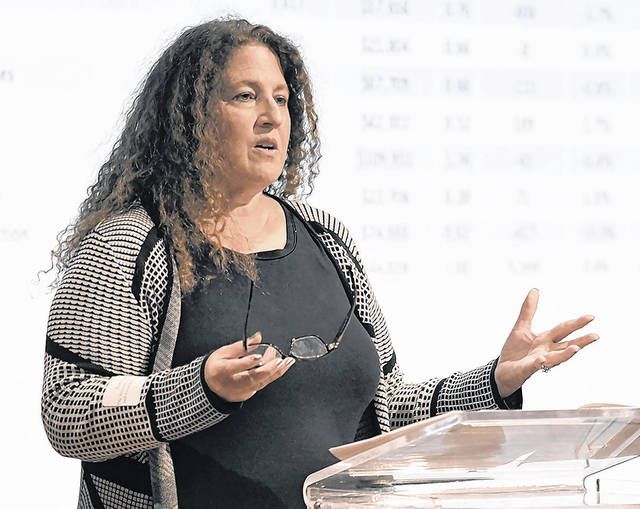Click here to subscribe today or Login.
WILKES-BARRE — Teri Ooms, executive director at The Institute for Public Policy & Economic Development at Wilkes University, this week said numerous individuals throughout Luzerne and Lackawanna counties and the Commonwealth face physical, economic, or social challenges.
“There is an ongoing need for social services to assist these citizens in their daily lives,” Ooms said. “The recipients of social services are often older individuals, those with mental and physical health challenges or disabilities, and lower-income families.”
Ooms said the 2021 Indicators Report showed a large portion of the population has faced the consequences of an uneven economy since the recession in 2008, and despite generalized economic growth in recent years, there remains a persistent demand for government-funded services as well as assistance from charitable and faith-based organizations.
“Moreover, the COVID-19 pandemic caused a spike in the acute need for support for families facing income loss,” Ooms said. “The pandemic has also appeared to widen already existing economic inequalities across gender, age, and race.”
Poverty is one issue behind the region’s continued need for social services. Child poverty rates in both counties have generally been higher than the statewide average. Furthermore, the percentage of households receiving SNAP benefits (often referred to as food stamps) was far higher in 2019 than it was prior to the last recession, at 17.6 percent regionally.
The statewide childhood poverty rate has shown a declining trend over the last few years, from 19.4 percent in 2015 to 16.8 percent in 2018, before marginally increasing to 16.9 percent in 2019. In most years, both Lackawanna and Luzerne counties have had child poverty rates above the statewide rate.
Both counties saw a jump in the childhood poverty rates between 2016 and 2017, and since then Luzerne County has seen a roughly level trend while Lackawanna County’s rate has fallen under 20 percent for the first time since 2016.
Cash assistance programs, such as Temporary Aid to Needy Families (TANF), provide additional income assistance to those who cannot work and to households that do not earn enough from work to support themselves.
Lackawanna County’s total number and share of households receiving cash assistance has fluctuated, but in 2019 reached the highest total seen since 2016 and the second highest since 2013.
In Luzerne County, the number of cash assistance recipients increased year-over-year from 3.1 percent in 2014 to 4.9 percent in 2018, before falling in 2019 to the lowest levels seen in the last decade.
Pennsylvania has expanded Medicaid under the Affordable Care Act to cover adults under 65 years with incomes up to 133 percent of the Federal Poverty Level as of January 1, 2015. As a result, a greater number of individuals are eligible for Medical Assistance, plateauing in 2018 and 2019 at about 27 percent in Lackawanna County and 28 percent in Luzerne.
However, these shares increases further in 2020 amid the global pandemic. Statewide and regionally, enrollment in the Children’s Health Insurance Program (CHIP) has typically grown for the last several years, but fell in 2020 as more families shifted to Medicaid due to changes in family income.
Older Pennsylvanians also possess a particular need for social support. Many senior citizens live on fixed incomes and face significant health care issues. Within the two-county region, the percent of the total population aged 65 and older remains higher than the statewide percentage, and the total number of seniors in the region is over 105,000. The number of individuals in the region with a disability has remained relatively steady, indicating a continued need for support for a variety of disabilities.
There are also several federal income tax credits that in ways similar to social assistance programming. The Earned Income Tax Credit (EITC) can provide significant income, in the form of an income tax refund, to lower income households. Regionally, about 18 percent of tax returns received the EITC as of 2018. The share of households receiving Child Tax Credits, and the average amount of the credit per return, grew due to expansion of that credit under the Tax Cuts and Jobs Act. Further tax credits and direct payments made in 2020 and 2021 also have an important impact on the financial situation of families.
The health and well being of our region’s children is critical to our future economic success. Today’s children are tomorrow’s workforce. Therefore, Pre-K – 12 education is the foundation. Keystone STARS is an initiative of the Office of Child Development and Early Learning (OCDEL). It was developed to improve, support, and recognize the continuous quality improvement efforts of early learning programs in Pennsylvania. Participating childcare and early learning programs are rated from one to four stars on several factors, such as teacher quality and adherence to safety regulations.
There has been significant year-to-year fluctuation in the number of participating centers. Both counties reached their highest levels in 2018, with 83 facilities in Lackawanna and 126 in Luzerne. Between 2018 and 2020, Luzerne County saw a decrease of ten STARS centers, and Lackawanna recorded a decline of three centers with at least 1 STAR. The number of 4-STAR (i.e. highest quality) centers has trended upward, however, and remained unchanged between 2019 and 2020 in both counties.
Reach Bill O’Boyle at 570-991-6118 or on Twitter @TLBillOBoyle.





